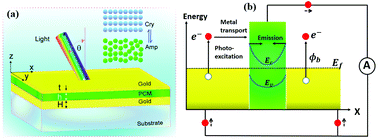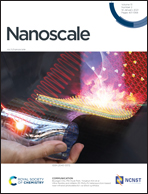Phase change material based hot electron photodetection
Abstract
We introduce a phase change material (PCM) based metal–dielectric–metal (MDM) cavity of gold (Au)–antimony trisulfide (Sb2S3)–Au as a hot electron photodetector (HEPD). Sb2S3 shows significant contrast in the bandgap (Eg) upon phase transition from the crystalline (Cry) (Eg = 2.01 eV) to the amorphous (Amp) (Eg = 1.72 eV) phase and forms the lowest Schottky barrier with Au in its Amp phase compared to conventional semiconductors such as Si, MoS2, and TiO2. The proposed HEPD is tunable for absorption and responsivity in the spectral range of 720 nm < λ < 1250 nm for the Cry phase and 604 nm < λ < 3542 nm for the Amp phase. The single resonance cavity and thus the sensitivity of the designed HEPD device can be changed to the double resonance cavity via the Cry to Amp phase transition. The maximum predicted responsivities for the single and double cavities are 20 and 24 mA W−1, respectively, at 950 nm and 1050 nm wavelengths which is the highest among all previously proposed planar HEPD devices. An anti-symmetric resonance mode at a higher wavelength is observed in the double cavity with 100% absorption. Owing to a high index of Sb2S3, an ultrathin ∼40 nm (∼λ/15) MDM cavity supports a critical light coupling to achieve high-efficiency HEPDs. Furthermore, a reversible and ultrafast (∼70 ns) Cry to Amp phase transition of Sb2S3 makes it suitable for many tunable photonics applications ranging from the visible to near-infrared region. Finally, we have introduced a novel scheme to switch between the single and double cavity by exploiting a semiconductor to metal phase transition in a PCM called VO2. The integration of VO2 as a coupling medium in the double cavity has increased the responsivity up to 50% upon phase transition to the metal phase. The proposed design can be used in optical filters, optical switches, ultrathin broad or narrow band solar absorbers, and other energy applications such as water splitting.



 Please wait while we load your content...
Please wait while we load your content...